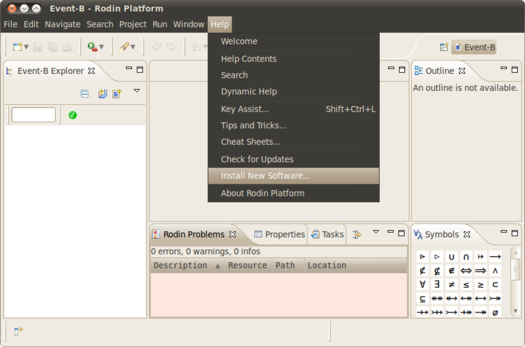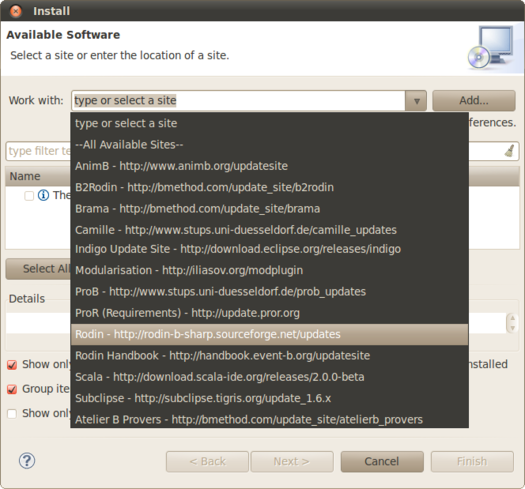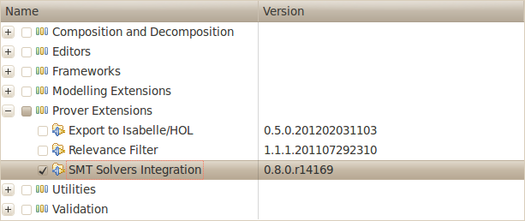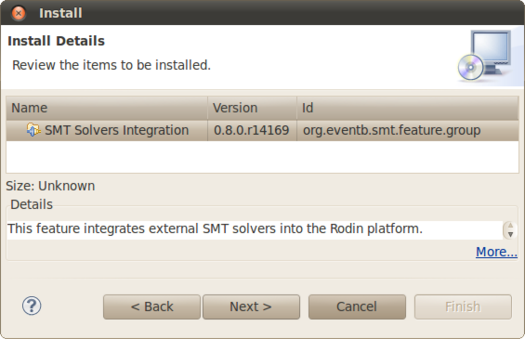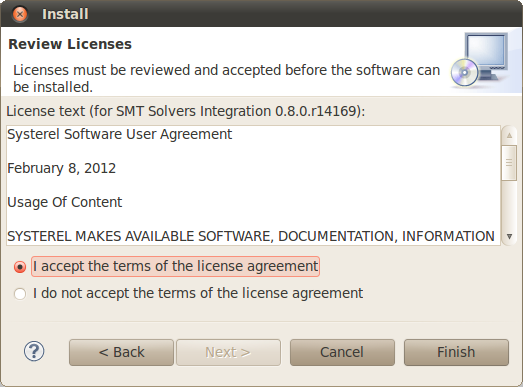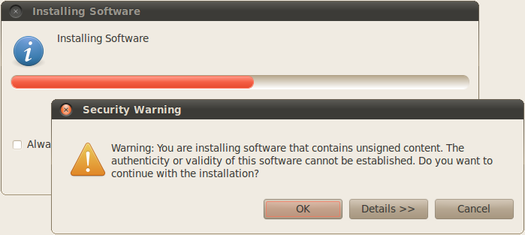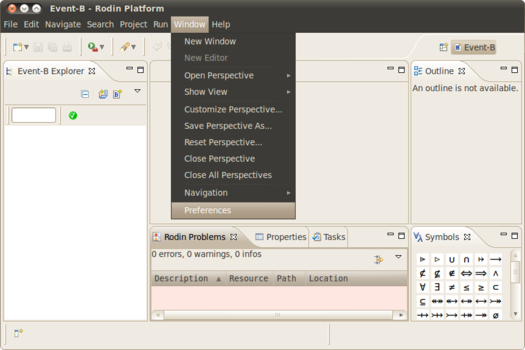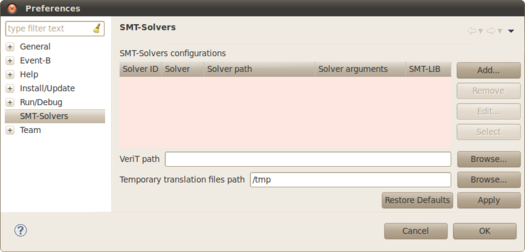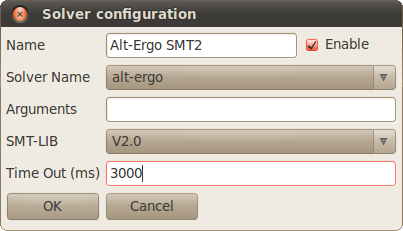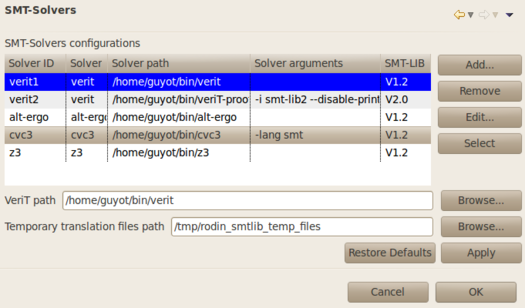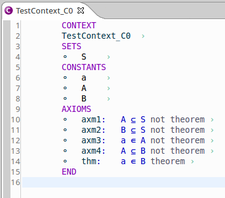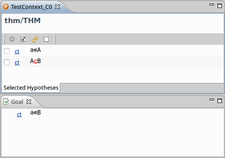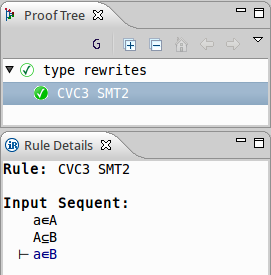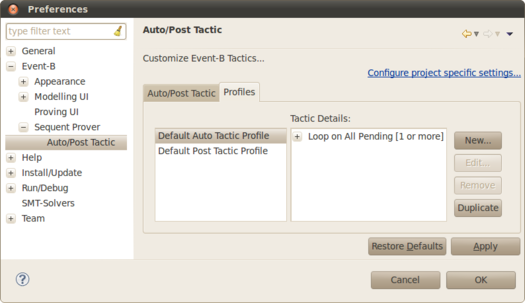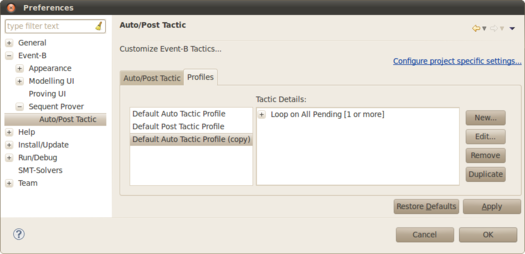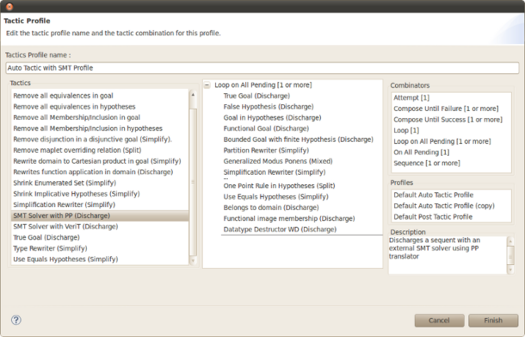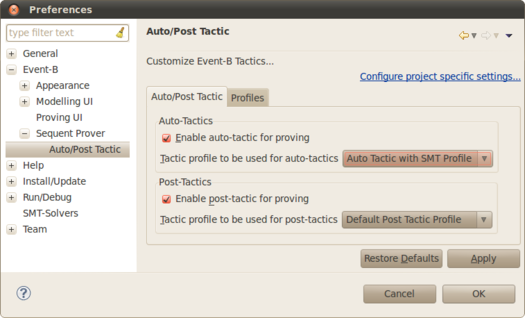SMT Solvers Plug-in: Difference between revisions
imported>YGU →SMT solvers configurations: Updated SMT Solvers configuration instructions. |
imported>YGU Updated user instructions. Added a tutorial to set up SMT auto-tactic. |
||
| Line 85: | Line 85: | ||
In order to use the plug-in, you must set up some SMT Solvers configuration. We call ''SMT Solver configuration'' a settled configuration of a solver, with ad-hoc properties such as its path, its parameters and the SMT-LIB version of the benchmarks it will execute. For example, such configurations can execute the same solver with different options, or different versions of the same solver, or different solvers. | In order to use the plug-in, you must set up some SMT Solvers configuration. We call ''SMT Solver configuration'' a settled configuration of a solver, with ad-hoc properties such as its path, its parameters and the SMT-LIB version of the benchmarks it will execute. For example, such configurations can execute the same solver with different options, or different versions of the same solver, or different solvers. | ||
As to reach the SMT solver configurations page, open the ''Preferences'' | As to reach the SMT solver configurations page, open the ''Preferences'' window: ''Window > Preferences''. | ||
[[Image:Preferences_menu.png|525px]] | [[Image:Preferences_menu.png|525px]] | ||
| Line 117: | Line 117: | ||
== Usage == | == Usage == | ||
=== Discharging a sequent === | |||
We give an example of Event-B model of which proof obligation can be discharge using an SMT solver: | We give an example of Event-B model of which proof obligation can be discharge using an SMT solver: | ||
| Line 140: | Line 142: | ||
For now, the proof tree doesn't contain any detail because SMT-LIB 1.2 doesn't implement a proof witnesses system. | For now, the proof tree doesn't contain any detail because SMT-LIB 1.2 doesn't implement a proof witnesses system. | ||
=== Setting-up an SMT auto tactic === | |||
One might want to set-up a configuration of SMT solver to be used automatically to discharge Event-b sequents in the Rodin platform. Since version 2.3 of Rodin, it is possible to create new ''tactic combinations'' to be applied automatically (See ''Advanced Profile Customisation'' in [[Rodin_Platform_2.3_Release_Notes]]). A reasonable combination using the SMT tactic is an SMT tactic queued to the default auto tactic combination. We show here how to create such a ''profile''. | |||
First, open the ''Preferences'' window of the Rodin platform: ''Window > Preferences''. | |||
[[Image:Preferences_menu.png|525px]] | |||
Open the ''Auto/Post Tactic'' preferences page: ''Event-B > Sequent Prover > Auto/Post Tactic''. Go to the ''Profiles'' tab. | |||
[[Image:Duplicating_auto_tactic_profile.png|525px]] | |||
Select the default auto tactic profile, and click ''Duplicate'' to duplicate it. | |||
Then, select the duplicated profile, and click ''Edit'' to edit it. | |||
[[Image:Auto_tactic_profile_duplicated.png|525px]] | |||
In the tactic profile window, rename the profile, and drag and drop the chosen SMT tactic from the tactics list (in the first column) to the end of the combined tactics (in the second column). | |||
[[Image:Adding_smt_tactic_in_profile.png|525px]] | |||
Then click ''Finish''. | |||
Now a new profile combining the SMT tactic with other tactics is created. To set it on, go to the ''Auto/Post Tactic'' tab. | |||
[[Image:Smt auto tactic profile selected.png|525px]] | |||
Set the tactic profile to be used for auto-tactics up to the one combining the SMT tactic, by using the drop-down menu. | |||
Then click ''Ok''. | |||
Now, the combined tactics of your new profile, including the SMT tactic, will be automatically launched when a new proof objective will be opened. | |||
== Bugs and features request == | == Bugs and features request == | ||
Revision as of 13:07, 20 October 2011
For developer support, see SMT Solvers Plug-in Developer Support
Introduction
The SMT plug-in allows users to use SMT solvers within Rodin. It is still in development (See sources [1]).
Installation
You will need to:
- Install the Rodin Platform.
- Install the SMT Solvers Plug-in into Rodin.
- Install veriT if you want to use it (instead of ppTrans) to translate Event-B to SMT-LIB.
- Install the SMT solvers you want to use.
Installing the Rodin Platform
Download the Rodin Platform 2.3 (Core) (around 61MB) corresponding to your operating system and install it [2].
Installing the SMT Solvers Plug-in
Launch Rodin and go to Help > Install New Software....
Select the Rodin Platform Update Site: http://rodin-b-sharp.sourceforge.net/updates.
Unfold the Prover Extensions category, and select the SMT Solvers Integration feature. Click Next.
Review the item to be installed and click Next.
Read and accept the terms of the license agreement to install the plug-in. Then click Finish.
A security warning appears because the feature content is unsigned. Click Ok.
Click Restart Now.
The SMT Solvers Plug-in is now installed.
Installing the SMT solvers
Currently, the SMT plug-in has been tested with the following solvers:
- Alt-Ergo (INRIA Saclay)
- CVC3 (New York and Iowa Universities)
- veriT (Loria Nancy and UFRN)
- Z3 (Microsoft Research)
Installing veriT
veriT solver can be downloaded at http://www.verit-solver.org/veriT-download.php. Compilation and installation instructions are in the INSTALL file. You must set off proof production in Makefile.config, because the SMT plug-in needs solvers to check satisfiability only:
PROOF_PRODUCTION = NO # PROOF_PRODUCTION = YES
The following tools are used in the installation process (Debian/Ubuntu platforms):
- gcc, g++: compilers
- make, ar, ranlib: build process
- wget, tar, patch: to fetch GMP and Minisat
- bison, flex, m4: build compilers and preprocessing
Do not forget to install the E-prover as well[3] (eprover package on Ubuntu platforms).
Installing Alt-Ergo
alt-ergo solver can be downloaded at http://alt-ergo.lri.fr/, or installed using the Ubuntu repository: alt-ergo package.
Installing CVC3
CVC3 solver can be downloaded at http://cs.nyu.edu/acsys/cvc3/download.html, or installed using the Ubuntu repository: cvc3 package.
Installing Z3
Z3 solver can be downloaded at http://research.microsoft.com/en-us/um/redmond/projects/z3/download.html.
SMT solvers configurations
In order to use the plug-in, you must set up some SMT Solvers configuration. We call SMT Solver configuration a settled configuration of a solver, with ad-hoc properties such as its path, its parameters and the SMT-LIB version of the benchmarks it will execute. For example, such configurations can execute the same solver with different options, or different versions of the same solver, or different solvers.
As to reach the SMT solver configurations page, open the Preferences window: Window > Preferences.
Go to the SMT-Solvers page.
Add a new SMT solver configuration into Rodin by clicking the Add button.
- Fill the Solver ID with the name you want to give to this configuration.
- Select the solver you want to use in this configuration (if it does not appear in the list, select unknown).
- Click Browse to fill the solver executable path.
- Fill the Solver arguments if needed. For now, veriT, Alt-Ergo and Z3 do not need any argument. CVC3 must be used with -lang smt argument.
- Select which version of SMT-LIB must be used by the plug-in. Currently, version 1.2 is the only one covered by the plug-in).
- Click OK.
The selected solver configuration is the blue one. This shows which solver configuration will be used when the SMT tactic will be called. If you want to use another solver configuration, click on the corresponding line in the SMT-Solvers configurations list, and click Select.
SMT-LIB translation settings
If you want to use veriT instead of ppTrans to translate Event-B sequents to SMT-LIB benchmarks, you need to fill the veriT path, by clicking the corresponding Browse button, and selecting the veriT binary.
The plug-in may use some temporary files to discharge a sequent. You can choose the directory to use for this purpose, by clicking the corresponding Browse button, and selecting the target directory.
Usage
Discharging a sequent
We give an example of Event-B model of which proof obligation can be discharge using an SMT solver:
thm1 is a theorem which must be proved given axioms axm2..axm5.
Since we installed SMT Plug-in into the Rodin Platform, the SMT tactic button is now accessible in the Proof Control bar.
Clicking on this button will call the previously selected SMT solver, which will discharge the proof obligation if possible:
When the tactic is applied successfully, this means that the reasonner created the new proof rule:
For now, the proof tree doesn't contain any detail because SMT-LIB 1.2 doesn't implement a proof witnesses system.
Setting-up an SMT auto tactic
One might want to set-up a configuration of SMT solver to be used automatically to discharge Event-b sequents in the Rodin platform. Since version 2.3 of Rodin, it is possible to create new tactic combinations to be applied automatically (See Advanced Profile Customisation in Rodin_Platform_2.3_Release_Notes). A reasonable combination using the SMT tactic is an SMT tactic queued to the default auto tactic combination. We show here how to create such a profile.
First, open the Preferences window of the Rodin platform: Window > Preferences.
Open the Auto/Post Tactic preferences page: Event-B > Sequent Prover > Auto/Post Tactic. Go to the Profiles tab.
Select the default auto tactic profile, and click Duplicate to duplicate it.
Then, select the duplicated profile, and click Edit to edit it.
In the tactic profile window, rename the profile, and drag and drop the chosen SMT tactic from the tactics list (in the first column) to the end of the combined tactics (in the second column).
Then click Finish.
Now a new profile combining the SMT tactic with other tactics is created. To set it on, go to the Auto/Post Tactic tab.
Set the tactic profile to be used for auto-tactics up to the one combining the SMT tactic, by using the drop-down menu.
Then click Ok.
Now, the combined tactics of your new profile, including the SMT tactic, will be automatically launched when a new proof objective will be opened.
Bugs and features request
- SMT-LIB 2.0 support in developpment
- Full set theory support in progress
Releases Notes
Version 0.1.0
- Initial beta-release.
- Two approaches for translating Event-B to SMT-LIB 1.2:
- with ppTrans (included in Rodin official releases)
- with veriT (must be installed)
- Integration of solvers successfully tested with: (notice that no solver will be included in the plug-in at all)
- Alt-Ergo 0.93
- Cvc3 2011-07-14
- veriT 201107
- z3 2.19
- Good results in the field of linear integer arithmetic with uninterpreted sort and function symbols
- Good support of basic set theory
- Full set theory support needs to be improved
- No SMT-LIB 2.0 support in this release
